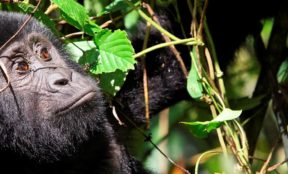Best tip we have about this bucket list trip?
If you can, go twice. You will see new things second time around. One hour is not enough, but it is an hour that you will remember for the rest of your life.
If gorilla trekking is not on your bucket list already, it should be. Up front and personal with gorillas in their environment is listed as one of 50 things to do before you die. The feeling of laying eyes on a family of rare mountain gorillas in the wild is hard to describe.
Going to Uganda to see the gorillas in the Bwindi Impenetrable park has certainly been very high on my list for a while now. The opportunity to be in their presence in a jungle in Africa is an inspirational adventure.
We’re going to tell you how to make it happen.
Ticking gorilla trekking off your list
Having seen orangutans in Borneo (another must do for wildlife fans) I know first-hand what a magical experience it is seeing these amazing creatures in their natural environment and it is one experience you keep for life, I promise.
Sitting among the gorillas, meeting those searching, intelligent eyes in a face that seems to reflect your own, is a powerful experience.
Why We Love It
- To get close to the rare mountain gorillas of Uganda on this intimate and unforgettable adventure is amazing.
- Bwindi is a tiny island of 330 sq km of equatorial primeval rainforest, surrounded by a sea of banana and tea plantations. A vast, misty, mountainous jungle, it is one of the most biologically diverse places in the world.
- Ugandans are some of the friendliest, most hospitable people in Africa. This is a gentle, graceful nation, despite its troubled past.
Uganda’s Bwindi Impenetrable Forest
Out of all the places to see gorillas in Africa – Rwanda, Uganda and DRC – Uganda’s Bwindi Impenetrable Forest is certainly one of the most magical and beautiful.
You’ll walk through one of the oldest and richest natural forests in the world, see rare birds – more than three-quarters of all the birds ever recorded in sub-Saharan Africa range through Uganda – meet welcoming people, stay in comfortable lodges and, of course, spend an astonishing hour with the park’s gorillas.
The Impenetrable Forest is in south-west Uganda, just over the border from Rwanda and a full day’s drive from Entebbe or Kampala, Uganda’s capital. The elevation ranges from 1160 to 2600 metres and it’s one of the world’s oldest forests.
Why gorilla trekking in Uganda?
It may be all about the gorillas for some, but for others, it’s about the mysteries of the forest and the heart-warming locals.
East Africa is famous for its forests, and Uganda is home to one of the lushest. Uganda is situated in East Africa with its neighbours Kenya, South Sudan, the Democratic Republic of Congo, Rwanda and Tanzania. It is in the African Great Lakes region, and has many significant lakes, including Lake Victoria, Lake Kyoga and Lakes Albert, Edward and George. This area is where the Nile River drains.
Famous for its national parks, Uganda has 60 protected sites including two UNESCO world heritage forests: the Bwindi Impenetrable National Park and Rwenzori Mountains National Park.
People are drawn here from all over the world for the breath-taking wildlife and world-class safaris. Perhaps the most exclusive and exhilarating of these trips is the gorilla trekking, which bring tears to the eyes, but tourists are never far from the equally rewarding experience of the Ugandan people.
The people
Uganda has a mix of various African ethnicities, including various Bantu, Sudanic, Nilotic and Kuliak groups. Ugandans are warm, welcoming people who value a good handshake and friendly chat upon meeting.
Other Ugandan Drawcards
Uganda’s other pluses are the range of other activities on offer. You can combine your gorilla trekking with the country’s other national parks and adventure activities, from hiking the glaciers in the Rwenzori Mountains to white-water rafting on the Nile, seeing lakes the size of countries, beautiful volcanic panoramas and the Murchison Falls. Uganda is an excellent safari destination and wildlife hotspots include Queen Elizabeth National Park to see lions and other big game, the Kibale Forest or Ngamba Island Chimpanzee Sanctuary to see chimps. The bird life is second to none.

A bit about the gorillas
The biggest threat to gorilla populations in Africa is poaching and loss of habitat. The business of gorilla tourism can be a tricky issue. I have always wanted to see gorillas, but I have also worried that gorilla trekking disturbs the gorillas or expose them to human disease. But the sad truth of the matter is that the gorillas probably wouldn’t be here at all without tourism. It is the one thing that can guarantee their survival. Tourism makes the gorillas worth more alive than dead, to both governments and the local people. Indeed, it is only through the efforts of the dedicated park staff that these highly endangered creatures survive at all.
Critically endangered
There are currently about 800 mountain gorillas left in Africa: 480 in the Virunga Volcanoes, which straddle Uganda, Rwanda and the Democratic Republic of Congo (DRC), and some 310-340 in Bwindi Impenetrable Forest, Uganda.
Are you guaranteed to see the gorillas in Bwindi?
Gorilla sightings can’t be guaranteed, but the chances of seeing the gorillas are very high in Bwindi. The park sends out trackers before you leave for your trek and they are always in contact with the group guides. These trackers usually know where the gorillas were the previous day and can find them fairly quickly.
The time it takes to find the gorillas also varies depending on the route you take into the mountain and at which lodge you are staying.
Best time to go?
While gorilla trekking can be done all year round, because of the rainy seasons in the mountain parks, many tourists often prefer the months from June to September and then December, January and February.
However, during the rains of March, April and May there’s plenty of gorilla food down slope. So, the gorillas keep to the lower slopes where it’s warmer and easier to get food. It’s more likely your trek to see them should take around 2 hours.
Is this trip right for you?
- Tracking gorillas in the dense forest can sometimes be wet, humid, muddy and uncomfortable. The terrain is by no means easy, so it can be pretty strenuous walking. You need to be prepared and fit enough to walk up to 4 hours up and down hills. But the sheer thrill of coming across a habituated group of gorillas, dominated by a great male silverback more than outweighs any difficulty.
- Travelling in November will allow you to take advantage of cheaper gorilla permits and cheaper prices. However, this is the rainy season. July, dry season, is considered to be peak season for trekking in Uganda and both permits and prices in general are more expensive.
- The gorilla trek is a shared activity. You may be split into different groups according to fitness level, and you may be accompanied by other travellers on your trek. However, there will only be a maximum of 8 people per gorilla family, plus a local Uganda Wildlife Ranger, and trackers.
All in all, Bwindi is one of the best places in central Africa to see the great mountain gorillas.
Cross it off your list today!
Have any other questions about gorilla trekking? Or do you want to share your own experience – gorilla-related or otherwise? Email us and tell us all about it. We’d love to share your experiences with our other intrepid travellers.
